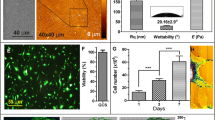Abstract
Substrate attachment is crucial for normal growth and differentiation of many cell types. To better understand the role of gravity in osteoblast attachment and growth in vitro, 17-day-old embryonic chick calvarial osteoblasts were subjected to directional variations with respect to gravity. Osteoblasts, grown in MEM or DME supplemented with 10% FBS and attached to type I collagen-coated coverslips, were loaded into cylindrical containers completely filled with medium and oriented so that cells were either atop or beneath, or coverslips continuously rotated (∼2 rpm) in a clinostat, thereby continuously changing their orientation with respect to gravity. Cells in these three conditions were collected daily for up to 6 days, and cell viability, two osteoblast functions, and proliferation were assessed. Data suggest the number and function of attached osteoblasts is unaltered by inversion or clino-rotation in initially confluent cultures. In sparsely plated cultures, however, osteoblast viability was significantly decreased (∼50%) in inverted and rotated cultures during the first 3 days of sampling, but from days 4–6 no significant difference was found in viable cell number for the three conditions. Decreases in viable cell number within the first days of the experiments could result from death followed by detachment, detachment followed by death, differences in proliferation rate, or lag-phase duration. To help distinguish among these, BrdU labeling for 2 or 24 hr was used to assess cell proliferation rate. Log-phase growth rates were calculated and were unchanged among the three conditions tested. These results point to an increase in lag-phase duration in inverted and rotated cultures. In summary, changing the cell-substrate attachment direction with respect to gravity causes an immediate response in the form of diminished viable osteoblast number in sparse, early cultures, but the effect disappears after 3–4 days and does not occur in mature, confluent cultures.
Similar content being viewed by others
References
Carmeliet G., Nys G., Stockmans I. and Bouillon R. 1998. Gene expression related to the differentiation of osteoblastic cells is altered by microgravity. Bone 22: 139s-143s.
Forkheim K.E. and Schenker E.B. 1998. Microgravity induced osteoporosis study on STS-80 space flight. Gravitational Space Biol Bull 12: 58.
Gerstenfeld L.C., Chipman S.D., Glowacki J. and Lian J.B. 1987. Expression of differentiated function by mineralizing cultures of chicken osteoblasts. Dev Biol 122: 49-60.
Gerstenfeld L.C., Toma C.D., Schaffer J.L. and Landis W.J. 1998. Chondrogenic potential of skeletal cell populations: selective growth of chondrocytes and their morphogenesis and development in vitro. Microscopy Res Techniques 43: 156-173.
Granet C., Boutahar N., Vico L., Alexandre C. and Lafage-Proust M.-H. 2001. MAPK and SRC-Kinases control ERG-1 and NF-KB inductions by changes in mechanical environment in osteoblasts. Biochem Biophys Res Corn 284: 622-631.
Gruener R. 1985. Simulated hypogravity and synaptogenesis in culture. Physiologist 28: S79-S80.
Gruener R. and Hoeger G. 1990. Vector-free gravity disrupts synapse formation in cell culture. Am J Physiol 258: c489-c494.
Gruener R. and Hoeger G. 1991. Vector-averaged gravity alters myocyte and neuron properties in cell culture. Aviat Space Environ Med 62:1159-1165.
Guignandon A., Lafage-Proust M.-H., Usson Y., Laroche N., Cail-lot-Augusseau A., Alexandre C. et al. 2001. Cell cycling determines integrin-mediated adhesion in osteoblastic ROS 17/2.8 cells exposed to space-related conditions. FASEB J 15: 2036-2038.
Holick M.F. 1998. Perspective on the impact of weightlessness on calcium and bone metabolism. Bone 22: 105S-111S.
Hughes-Fulford M. and Lewis M.L. 1996. Effects of microgravity on osteoblast growth activation. Exp Cell Res 224: 103-109.
Hughes-Fulford M., Tjandrawinata R., Fitzgerald J., Gasuad K. and Gilbertson V. 1998. Effects of microgravity on osteoblast growth. Gravitational Space Biol Bull 11: 51-60.
Kacena M.A. 1999. Osteoblast modulation by gravitational forces, PhD dissertation, University of Colorado.
Kaplansky A.S., Durnova G.N., Burkovskaya T.E. and Vorotnikova EV. 1991. The effect of microgravity on bone fracture healing in rats flown on Cosmos-2044. Physiologist 34: S196-S199.
Kostenuik P.J., Halloran B.P, Morey-Holton E.R. and Bikie D.D. 1997. Skeletal unloading inhibits in vitro proliferation and differentiation of rat osteoprogenitor cells. Am J Physiol 273: E1133-E1139.
Kunisada T., Kawai A., Inoue H. and Namba M. 1997. Effects of simulated microgravity on human osteoblast-like cells in culture. Acta Med Okayama 51: 135-140.
Landis W.J., Hodgens K.J., Block D., Toma C.D. and Gerstenfeld L.C. 2000. Spaceflight effects on cultured embryonic chick bone cells. J Bone Min Res 15: 1099-1112.
Luttges M.W. 1992. Recognizing and optimizing flight opportunities with hardware and life sciences limitations. Transactions of the Kansas Academy of Science 95: 76-86.
Miyamoto A., Shigematsu T., Fukunaga T., Kawakami K., Mukai C. and Sekiguchi C. 1998. Medical baseline data collection on bone and muscle change with space flight. Bone 22: 79S-82S.
Roberts W.E., Mozsary P.G. and Morey E.R. 1981. Suppression of osteoblast differentiation during weightlessness. Physiologist 24: S75-S76.
Roberts W.E., Fielder P.J., Rosenoer L.M.L., Maese A.C., Gonsalves M.R. and Morey E.R. 1987. Nuclear morphometric analysis of osteoblast precursor cells in periodontal ligament, SL-3 rats. Am J Physiol 252: R247-R251.
Sarkar D., Nagaya T., Koga K., Nomura Y., Gruener R. and Seo H. 2000. Culture in vector-averaged gravity under clinostat rotation results in apoptosis of osteoblastic ROS 17/2.8 cells. J Bone Miner Res 15: 489-498.
Sato A., Hamazaki T., Oomura T., Osada H., Kakeya M., Watanabe M. et al. 1999. Effects of microgravity on c-fos gene expression in osteoblast-like MC3T3-E1 cells. Adv Space Res 24: 807-813.
Smith J.D., Staehelin L.A. and Todd P. 1999. Early root cap development and gravity response in white clover (Trifolium rapens) grown in space and on a two-axis clinostat. J Plant Physiol 155: 543-550.
Vico L., Lafage-Proust M.-H. and Alexandre C. 1998. Effects of gravitational changes on the bone system in vitro and in vivo. Bone 22: 95S-I00S.
Zhang X., Wang G., Ding B., Yue M., Tan Y. and Zeng Y. 1998. Effects of simulated weightlessness and gamma-irradiation on myocardial cells and osteoblasts. Space Med Med Eng 11: 313-317.
Author information
Authors and Affiliations
Rights and permissions
About this article
Cite this article
Kacena, M.A., Todd, P., Gerstenfeld, L.C. et al. Experiments with osteoblasts cultured under varying orientations with respect to the gravity vector. Cytotechnology 39, 147–154 (2002). https://doi.org/10.1023/A:1023936503105
Issue Date:
DOI: https://doi.org/10.1023/A:1023936503105




